![]()
HOME------FICTION------NON-FICTION------LOCALS------ABOUT![]()
Boardrider of the Month: John Hughes
The Beachside Resident - April 2011
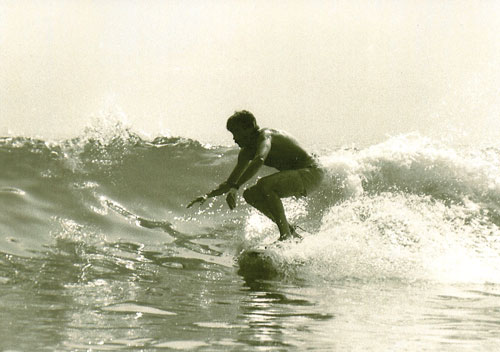
Chances are, John Hughes is more of a local than you are.
If numbers count for anything, he’s been here since 1954. And he’s surfed Cocoa Beach for the better part of 50 years.
He is that certain type of man who looks strikingly familiar, though you might be seeing him for the first time. Silver-haired, statuesque, his face perpetually beatific, he carries himself with the grace of a humble wizard, or perhaps a trainer of unicorns. There is something ethereal about him, something that suggests he might not belong here on dry land… And yet he is a third-degree black belt in Aikido (“the way of the harmonious spirit”). This might help explain his ease of carriage, but John shrugs it off, says it is something to keep him balanced, something to do when there aren’t waves.
John Hughes rides more boards than you do, too. From double-hulled stand-up paddleboards to shortboards, to logs, fish, tugs, paipos, surf mats… he’s ridden it, and ridden it well. He’s a trained Navy diver, a veteran of Hawaii’s north shore, and a traveler of the wide seas. But above all these things, John Hughes is a Waterman.
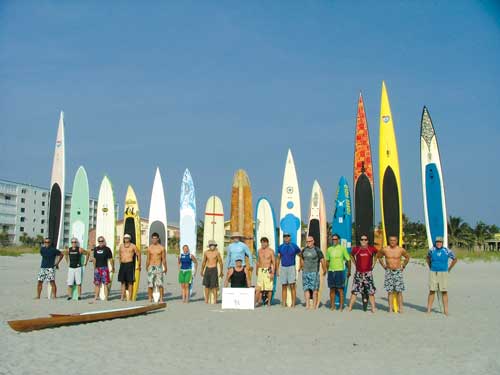
His passion for the sea has led him to organize two of the biggest paddleboard races in the state — the Causeway to Causeway Challenge and the Florida State Paddleboard Championship. He also happens to be the President of the Cocoa Beach Surf Museum, which will open the doors on its most ambitious exhibit to date — a dedication to the world’s greatest surfer, Kelly Slater — on Saturday, April 23.
I joined John at his home, where we spoke under the canopy of some live oak trees speckled with orchids, and where I more than once heard the far-off whinnying of unicorns.
When did you start surfing?
In ’63 my family moved into a little neighborhood in Cocoa Beach, right across the street from this guy, Greg Pichel, who built the first surfboard I ever saw in his front yard. Pichel had a kid about my age who used to take me in the water on one of those little wooden paipo boards. I’m not sure why our parents let us stay out alone all day, being so young, but they did. When I was twelve, my dad got me a real surfboard for my birthday. He said it was the first and last one he’d ever buy for me. And he stuck to that.
What was Cocoa Beach like in the 60s?
It was an amazing place to grow up. A lot of families came in for the Space Program, with tons of kids all about the same age. The beach was accessible from anywhere. You could ride your bike through town all day long without having to worry about anything. The islands and the river were right behind our houses, and just about every kid I knew had a twelve-foot john boat with a ten horse motor. That’s how we got around — boats and bikes. We’d run wild through the mangrove islands, or just surf all day. It was a good place to grow up.
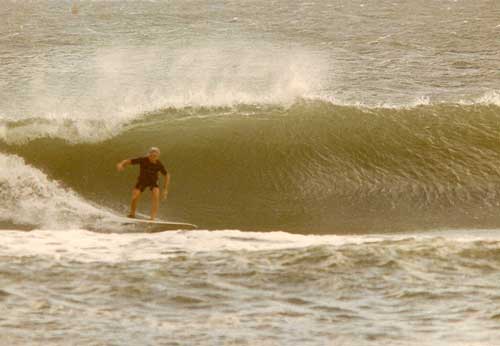
Explain to me the “Waterman’s Ethic.”
The Waterman’s Ethic is an unwritten philosophy, sort of a yardstick to determine the worthiness of people who surf. Basically, a Waterman is expected to be knowledgeable in all aspects of the ocean. He should feel comfortable at any time, under any circumstances. He should be competent in any number of ocean-related skills besides surfing, including paddleboarding, spear-fishing, ocean swimming, sailing… He should be proficient and comfortable in any situation.
The Florida State Paddleboard Championship gets bigger each year. How has it been, adjusting to the rising popularity of SUPs?
It’s been fun. 2007 was the first time we saw stand-ups in a paddleboard race on the east coast. Two guys showed up, and I told them they could go ahead and paddle, but they wouldn’t get trophies or anything. The wind shifted that day, turned out of the north at 20 knots, and these guys made quite an impression. That same year, we had the first stand-up surfing event at the Waterman’s. The paddleboard community is different in some ways than the surfing community. There’s a lot of camaraderie there.
In the 60s we had the shortboard revolution. Would you say in this decade we’re witnessing a stand-up paddleboard revolution?
There are a lot of parallels. If anything, the jump in technologies, the construction, the different directions paddleboards are going… It’s moving even faster than the shortboard revolution.
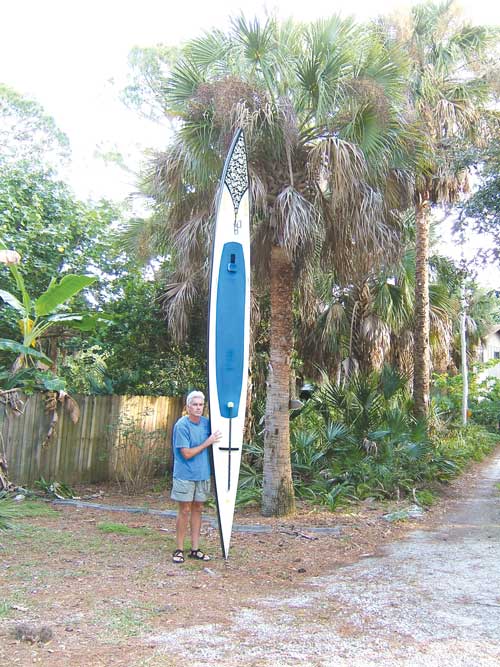
You’re known as a guy with a pretty eclectic quiver. What’s the most unique shape you’ve ever ridden?
A friend of mind, Mark Wessling, down in Miami, is one of only a dozen guys in the world still riding Greenough flexspoons. A flexspoon is what would you get if you took a longboard, cut the nose off it, and scooped almost all the foam out of the inside, leaving only enough to keep the thing from sinking. George Greenough was the father of shortboarding. He was riding these sub five-foot kneeboards in the early 60s — it was almost like somebody dropped out of Mars with an alien spaceship and started surfing. He wanted to be able to maneuver quicker than the longboards, so he designed a board that could flex and take on the contours of the wave. It was very advanced.
What are you riding today?
I’m getting into a 6’10″ Davo fish that I’m having a lot of fun with. I’ve also got an 8’4″ Stu Sharpe speed log, a couple of longboards I break out when it’s really small. Other than that, it’s my surf mat.
What is your dream surf trip?
Jeffrey’s Bay. Although it might be too cold for me. I love point breaks. That’s what you don’t get in Florida. Pavones would be on the list. Peru is flooded with barely ridden point breaks. I went there once, surfed a few of the places. There’s a lot of untapped potential in Peru.
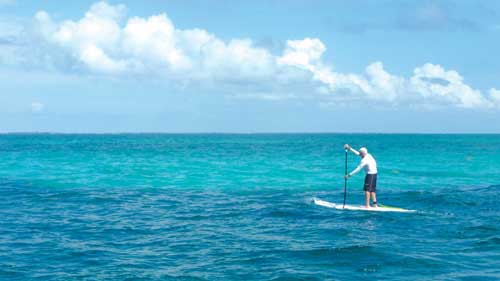
What’s the most exotic place you’ve ever surfed?
Diego Garcia. It’s a little dot in the middle of the Indian Ocean, about as far as you can be from land and still be on the planet. I was stationed there. We had to hide our boards in the jungle, cover them with palm fronds, and sneak out to catch waves when nobody was looking.
How about the gnarliest wave?
What these guys are surfing nowadays puts what we were doing back then to shame. But it was Sunset Beach. That was my favorite break. Just a great wave. It’ll humble you at any time, without warning, regardless of how long you’ve been surfing out there.
The Surf Museum has done both classic and new school exhibits, ranging from the Duke to Kelly Slater. Which era of surfing history do you find most interesting?
I’m fascinated by early Hawaiian, pre-contact surfing. The ancient Hawaiians were surfing at least five or six hundred years before we knew they were there. I can’t imagine what was going on doing during all those centuries. We’ve got maybe hundred years that we consider modern surfing, but before that, there must have been some amazing things going on. The whole Hawaiian society revolved around the ocean and surfing. They were fanatical about it, to the point that our surfing culture looks tame in comparison. The common misconception is that the old Hawaiians were riding big heavy surfboards, just going straight, and that the boards weren’t very maneuverable. Now, with the revival of all the retro shapes, and these kids riding the little wood alaias… You see what they’re doing now, and you can just imagine that the ancient Hawaiians must have been doing that, and even more, for hundreds of years.
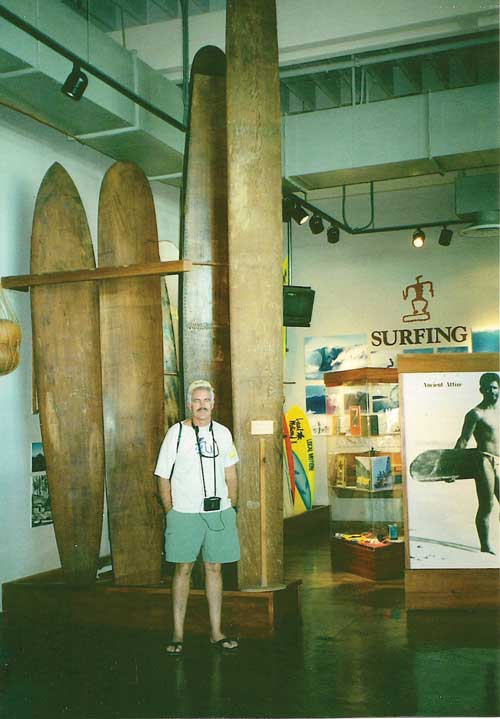
Because there’s no technological reason they couldn’t be riding alaias back then?
They undoubtedly did. Competition and betting was rampant in their civilization. I’m sure they were doing everything they could to outperform and outshine the other guy.
Are you suggesting the ancient Hawaiians might have surfed Pipeline?
Sure. The kings were doing tow-in surfing. They took their outrigger canoes and sixteen-foot olos out to these cloudbreaks in the middle of nowhere. They’d get the canoe up to speed and mount these monster waves .
What’s your idea of a perfect day?
It’d have to be warm. What I’d consider a perfect day now is downsized from twenty years ago. Head high, clean, glassy. I like speed, and I like to cover distance, so it’d have to be lined up and going fast.
Tell me about the grand opening of the Kelly Slater exhibit.
We’re expecting a big turnout. The grand opening party is 7 p.m., Saturday night, April 23. Easter surfing weekend. There’s going to be live music, drinks, food. A lot of well-known surfers are going to be coming out. It should be fun.
The Cocoa Beach Surf Museum is located in the Ron Jon’s Watersports building, at the corner of 520 and A1A. The Florida State Paddleboard Championship race runs a 7-mile course, and leaves from Cocoa Beach’s Shepard Park.
![]()
